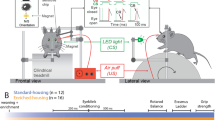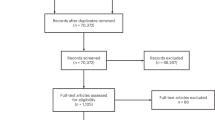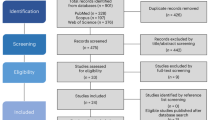Abstract
Environmental enrichment is an essential component of laboratory animal housing that allows animals to engage in natural behaviors in an otherwise artificial setting. Previous research by the authors suggested that, compared with synthetic enrichment materials, natural materials were associated with lower stress levels in mice. Here, the authors compare the effects of different enrichment materials on stress, memory and exploratory behavior in Swiss Webster mice. Mice that were provided with natural enrichment materials had lower stress levels, better memory and greater exploratory behavior than did mice provided with synthetic enrichment materials or with no enrichment materials. These findings suggest that provision of natural enrichment materials can improve well-being of laboratory mice.
This is a preview of subscription content, access via your institution
Access options
Subscribe to this journal
We are sorry, but there is no personal subscription option available for your country.
Buy this article
- Purchase on Springer Link
- Instant access to full article PDF
Prices may be subject to local taxes which are calculated during checkout





Similar content being viewed by others
References
Baumans, V. in Animal Alternatives, Welfare, and Ethics (Elsevier Science, Amsterdam/New York, 1997).
Baumans, V. in The Welfare of Laboratory Animals (Springer, Dordrect, the Netherlands, 2004).
Poole, T.B. in Second Nature: Environmental Enrichment for Captive Animals (Smithsonian Institution Press, Washington, DC, 1998).
Van de Weerd, H.A., Van Loo, P.L., Van Zutphen, L.F., Koolhaas, J.M. & Baumans, V. Preferences for nesting material as environmental enrichment for laboratory mice. Lab. Anim. 31, 133–143 (1997).
Van de Weerd, H.A., Van Loo, P.L., Van Zutphen, L.F., Koolhaas, J.M. & Baumans, V. Nesting material as environmental enrichment has no adverse effects of behavior and physiology of laboratory mice. Physiol. Behav. 62, 1019–1028 (1997).
Hohoff, C. Anxiety in mice and men: a comparison. J. Neural Transm. 116, 679–687 (2009).
Olsson, I.A. & Dahlborn, K. Improving housing conditions for laboratory mice: a review of 'environmental enrichment'. Lab. Anim. 36, 243–270 (2002).
DeFries, J.C. Prenatal maternal stress in mice: differential effects on behavior. J. Hered. 55, 289–295 (1964).
Estanislau, C. & Morato, S. Prenatal stress produces more behavioral alterations than maternal separation in the elevated plus-maze and in the elevated T-maze. Behav. Brain Res. 163, 70–77 (2005).
Schwabe, L. & Wolf, O.T. Learning under stress impairs memory formation. Neurobiol. Learn. Mem. 93, 183–188 (2010).
Conrad, C.D. A critical review of chronic stress effects on spatial learning and memory. Prog. NeuroPsychopharmacol. Biol. Psychiatry 34, 742–755 (2010).
Gerlai, R. A new continuous alternation task in T-maze detects hippocampal dysfunction in mice: a strain comparison and lesion study. Behav. Brain Res. 95, 91–101 (1998).
Harri, M. et al. Effects of access to a running wheel on behavior of C57BL/6J mice. Lab. Anim. Sci. 49, 401–405 (1999).
Williams, B.M. et al. Environmental enrichment: effects on spatial memory and hippocampal CREB immunoreactivity. Physiol. Behav. 73, 649–658 (2001).
Wolfer, D.P. et al. Laboratory animal welfare: cage enrichment and mouse behaviour. Nature 432, 821–822 (2004).
Wurbel, H. Ideal homes? Housing effects on rodent brain and behavior. Trends Neurosci. 24, 207–211 (2001).
Henderson, N.D. Brain weight increases resulting from environmental enrichment: a directional dominance in mice. Science 169, 776–778 (1970).
Dawkins, M.S. From an animal's point of view: motivation, fitness, and animal welfare. Behav. Brain Sci. 13, 1–9 (1990).
Garner, J.P. Stereotypies and other abnormal repetitive behaviors: potential impact on validity, reliability, and replicability of scientific outcomes. ILAR J. 46, 106–117 (2005).
Van de Weerd, H.A. et al. Effects of environmental enrichment for mice: variation in experimental results. J. Appl. Anim. Welfare Sci. 5, 87–109 (2002).
Wurbel, H. & Garner, J.P. Refinement of Rodent Research through Environmental Enrichment and Systematic Randomization (National Centre for the Replacement, Refinement and Reduction of Animals in Research, London, 2007).
Baumans, V. Environmental enrichment for laboratory rodents and rabbits: requirements of rodents, rabbits, and research. ILAR J. 46, 162–170 (2005).
Blanchard, R.J. & Blanchard, D.C. Bringing natural behaviors into the laboratory: a tribute to Paul MacLean. Physiol. Behav. 79, 515–524 (2003).
Blom, H.J., Van Tintelen, G., Van Vorstenbosch, C.J., Baumans, V. & Beynen, A.C. Preferences of mice and rats for types of bedding material. Lab. Anim. 30, 234–244 (1996).
Sherwin, C.M. Observations on the prevalence of nest-building in non-breeding TO strain mice and their use of two nesting materials. Lab. Anim. 31, 125–132 (1997).
Jennings, M. et al. Refining rodent husbandry: the mouse. Lab. Anim. 32, 233–259 (1998).
Touma, C., Palme, R. & Sachser, N. Analyzing corticosterone metabolites in fecal samples of mice: a noninvasive technique to monitor stress hormones. Hormones Behav. 45, 10–22 (2004).
Adams, N. & Boice, R. A longitudinal study of dominance in an outdoor colony of domestic rats. J. Comp. Psychol. 97, 24–33 (1983).
Adams, N. & Boice, R. Development of dominance in domestic rats in laboratory and seminatural environments. Behav. Processes 19, 127–142 (1989).
Lore, R. & Flannely, K. Rat societies. Sci. Am. 236, 106–116 (1977).
Gaskill, B. et al. Heat or insulation: behavioral titration of mouse preference for warmth or access to a nest. PLoS ONE 7, e32799 (2012).
Acknowledgements
We thank the University of Nevada School of Medicine Laboratory Animal Care Service for protocol assistance. We also thank Dr. John J. Hasenau and Dr. Richard Simmonds for their support. Finally, we thank BioServ and Enzo Life Sciences for donations of materials.
Author information
Authors and Affiliations
Corresponding author
Ethics declarations
Competing interests
Enrichment materials for this study were donated by Bio-Serv.
Rights and permissions
About this article
Cite this article
Acklin, C., Gault, R. Effects of natural enrichment materials on stress, memory and exploratory behavior in mice. Lab Anim 44, 262–267 (2015). https://doi.org/10.1038/laban.735
Received:
Accepted:
Published:
Issue Date:
DOI: https://doi.org/10.1038/laban.735



